Thanks to my wife’s collection of show horses, I spend at least one a day week pulling a trailer and this heavy towing activity allows me the opportunity to put new trucks and SUVs to work. While many people might review the 2014 Toyota Tundra based on its abilities to drive 20 miles across the city or to head on a fishing trip that doesn’t have the truck leaving paved roads, the Tundra that was delivered to my house recently was in for a week of work. I perform similar tasks with every truck and SUV (when applicable) that I test as the horse owning world is very routine so from towing a 5,000lb horse trailer down a miserably rough dirt road to hauling 1,200lbs of grain in the bed – my Tundra Platinum Crew Max test truck faced more work in a week than many trucks in the US handle in a year.
Before getting into the bulk of this review of the 2014 Toyota Tundra Platinum Crew Max, I want to explain a few things about the current full size truck market. Ten years ago, there was a massive difference in the qualities and capabilities of the various half ton trucks sold in America. I’m sure that even Toyota would admit that the Tundra was not a true competitor for the likes of the Dodge Ram 1500, the Ford F150 or the Chevrolet Silverado. However, with the introduction of this new Tundra for the 2014 model year, the gap between the Ram, Silverado, F150 and Tundra is smaller than ever.
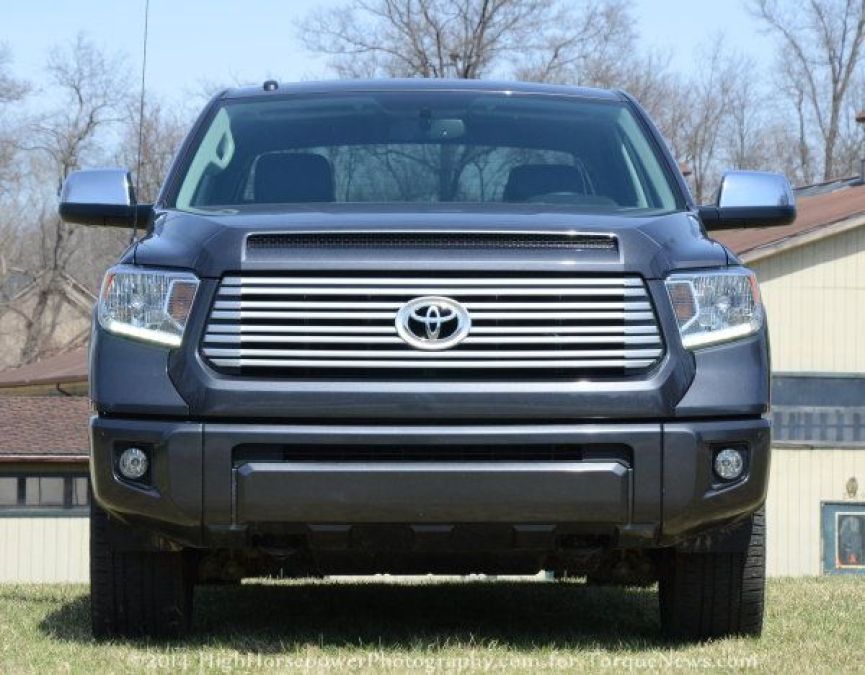
Someone who has no real experience in any of these modern half ton pickups will likely notice very little difference from one to the other as this battle has become one of inches. If someone has never had a full size pickup before or perhaps they have only ever owned a truck from the 1980s or 1990s, the Ford, Toyota, Ram and Chevy entries into this massive segment are all going to seem like incredible trucks. However, as someone who has driven most of the trucks sold in America and who spends a ton of time hauling and towing with the newest trucks on the market – there are pros and cons to every truck on the list. It is a true battle of inches and it will be those super fine details that I examine in this review of the new Tundra Platinum.
My 2014 Toyota Tundra Platinum 4x4 Crew Max sits just one step from the top of the line for the current full size Toyota pickup – ranking below only the 1794 Edition. The Platinum trimline is so well appointed that the only option is the Blind Spot Monitoring system, which my test truck had in addition to a couple essential accessories including the side step bars ($345) and a bedliner ($365). The sticker price of this loaded up truck with a few optional accessories was $49,525 including destination.
The Platinum Package Packs Serious Luxury
While the 2014 Toyota Tundra Platinum Crew Max isn’t the tip top of the model range, you would be hard pressed to tell that by looking at the interior. As soon as you open the door of the new Tundra you are greeted by a cabin that is filled with black leather – from the plush front bucket seats and the 60/40 folding rear seats to the center console, the steering wheel, the dashboard and the door panels – this Toyota pickup is luxury quality inside. The front seats and rear outboard seats offer a feel like a living room recliner or sofa with heated and cooler surfaces up front guaranteeing comfort in all climate conditions. Those folks seated in the rear don’t get the climate controlled seats, but there is a friendlier seat-back angle than what is offered by some competitors so rear riders are able to sit more comfortably on a long ride than they would be in some of the other four door trucks available today. In short, the interior looks very comfortable because it is very comfortable and it looks like a seating layout that would just as easily fit in the Lexus lineup – and that is really saying something.
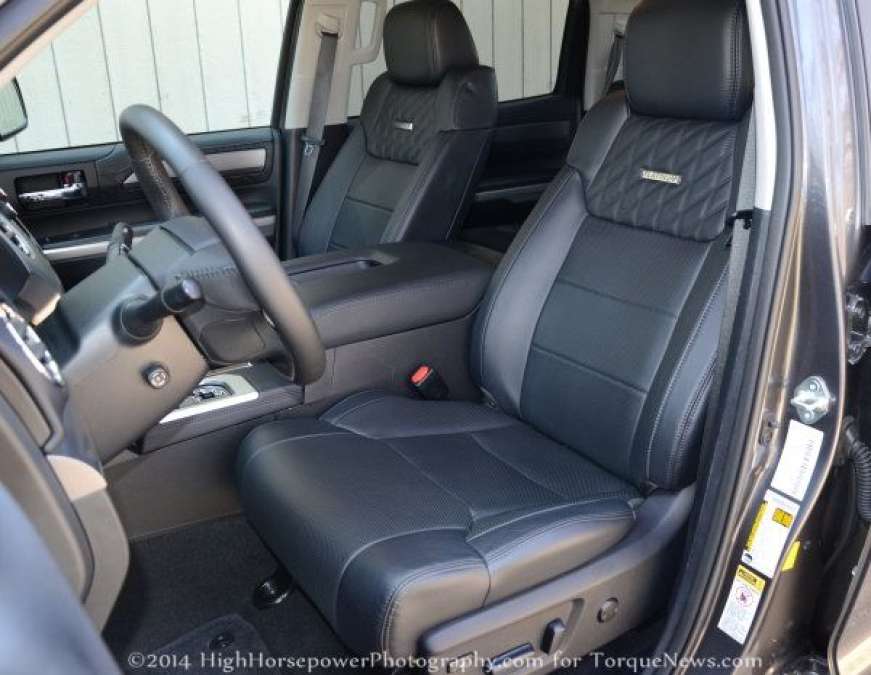
In addition to offering comfortable seats, the 2014 Toyota Tundra Platinum Crew Max offers a massive amount of space for passengers and cargo. The huge cab allows enough room in every direction that both front and rear riders won’t have any complaints about leg, knee, elbow, shoulder or head room. Whether the driver is very tall or very short, the driver’s seat adjusts to accommodate a wide variety of people while the passenger’s seat and rear seats will easily fit a collection of large occupants over 6 feet tall. When you need some extra interior cargo space, the rear seats fold up in a 60/40 formation with the simple pull of a level mounted on the outer edge of the seats. My only real complaint with this system (or with the entire Tundra interior) is the way that the rear seats fold up. They do not slide at all so when you fold them against the back of the cab, the mounting brackets for the seats can get in the way of large boxes sliding in and out of the back doors and for lack of a better word – the back seat bases when folded up are a bit intrusive. Competitors who use the fold away back seat have thinner seat bases that don’t stick out as far when folded up so those trucks have more room for larger cargo than you will get with the Tundra. However, the Crew Max cab offers a ton of cargo space that will more than satisfy most new truck buyers even with the seats sticking out a bit.
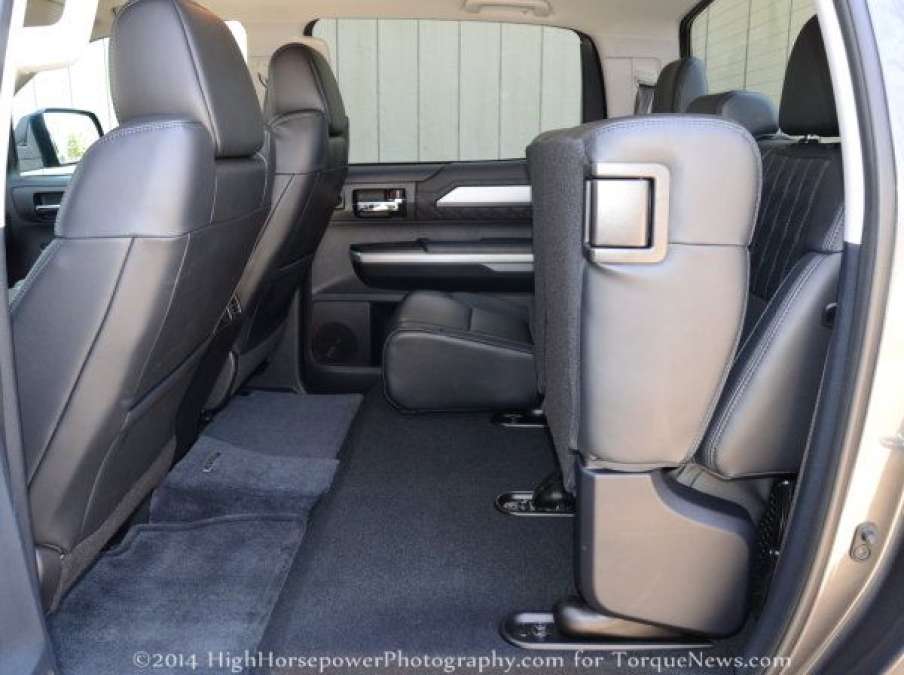
Accenting all of the black leather throughout the interior of the 2014 Toyota Tundra Platinum Crew Max is a ton of silver trim on the dash, on the steering wheel and through the gauge cluster. The centerpiece of the 2014 Tundra interior is the new high tech infotainment system that uses a big, bright touch screen to access and control features like the Navigation, the sound system, the hands free phone system, traffic information, weather information and all of the various system settings. This is a fairly user friendly system, offering some traditional buttons and knobs around the perimeter of the touch screen for those who like some old school controls while the steering wheel controls allow the driver to adjust pretty much everything with either the buttons or their voice. My only complaint of this infotainment system is the lack of a dedicated navigation/map button, forcing you to go into the Apps menu to bring up the nav system and in this day and age – the navigation should be a big enough priority to get its own button on the console. Thanks to a speaker system from JBL, this Tundra has a pretty hard charging sound system that will please audiophiles who like rock, rap or country.
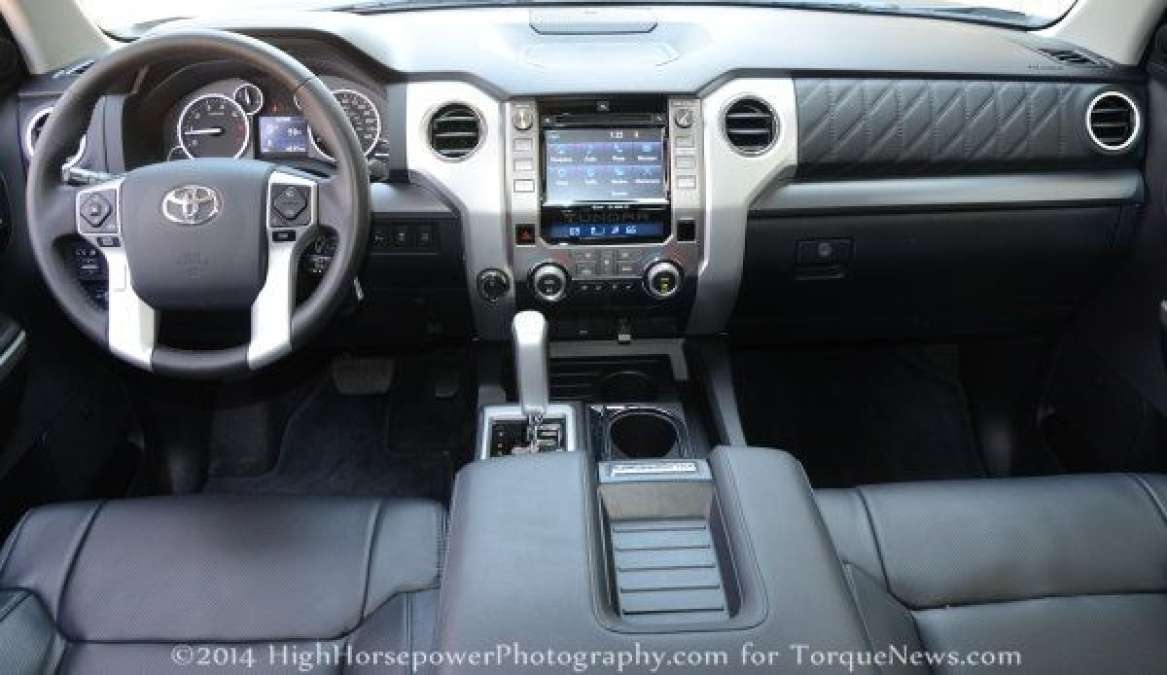
Below the infotainment screen is a very easy to use HVAC panel that puts everything at arm’s reach for the driver or passenger, with dedicated temperature knobs for the driver and passenger with a digital display that shows the chosen temperature settings, the fan speed and the direction of the cooled or heated air. This small panel also contains the buttons for the heated and cooled front seats Finally, just below the HVAC panel is a roomy storage cubby joined by a collection of cup holders as you get back to the big, roomy center console that serves as a comfy armrest while also providing a ton of hidden storage space.
The Drive
During my time driving the 2014 Toyota Tundra Platinum Crew Max, I spent time driving on the highway, on local paved roads and on local unpaved roads both with and without my horse trailer. With a loaded weight of a touch above 5,000lbs, my horse trailer is far from the heaviest trailer that the Tundra is capable of towing. In fact, the Tundra that I spent a week working out is capable of towing up to 9,500lbs and haul up to 1,415lbs so I came far from pushing this big Toyota pickup to its limits – but it faced the same tests as so many other trucks before.
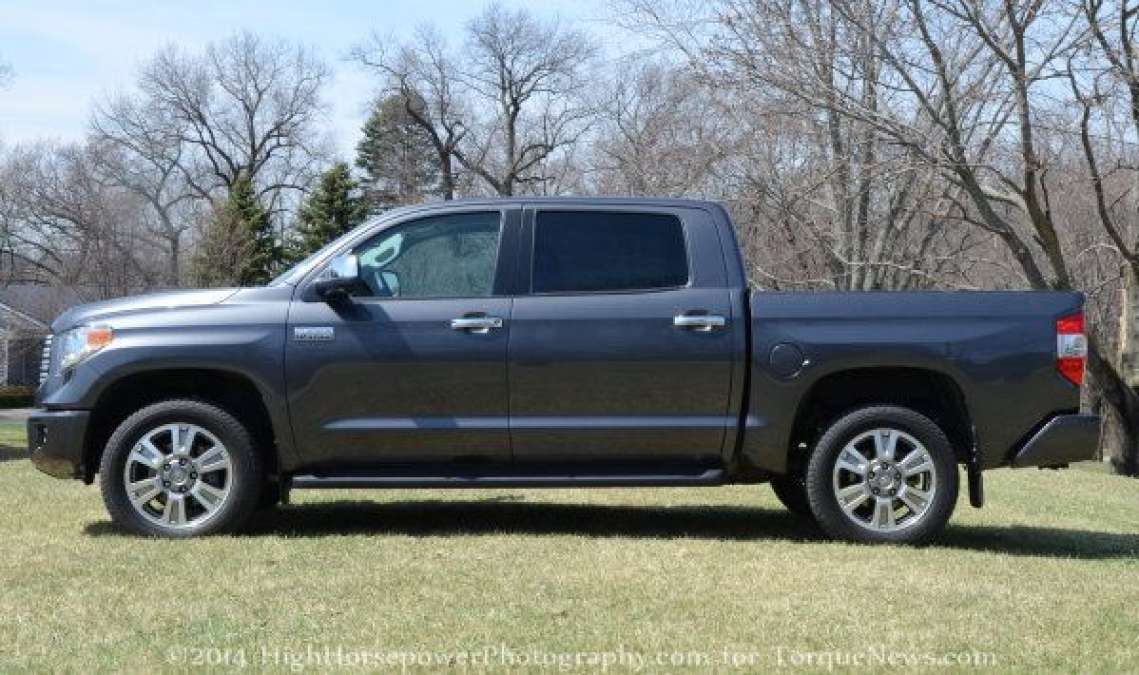
My Tundra test truck was fitted with the 5.7L iForce V8 that sends 381 horsepower and 410lb-ft of torque to all four wheels via a 6-speed automatic transmission. This is one of the most powerful engines in the half ton segment and, predictably, that affords you plenty of acceleration from a stop or when you are cruising on the highway. Whether you are driving by yourself with no load or when you are driving with a full cab, a loaded bed and a loaded up trailer out back – the Tundra never feels short of power. In terms of go-fast fun in a straight line, the Tundra offers almost as much hustle as any truck on sale today and while a timed drag race down the quarter mile might not find the big Toyota victorious – it provides more than enough power to do everything that an owner will need to do while also allowing you to comfortably eclipse any posted speed limit with relative ease.
Hitting The Road
For a measure of the handling and ride quality, the vast majority of Toyota Tundra Platinum drivers (and every other half ton truck sold in America) likely spend a great deal of time driving on smooth, paved roads so that was where I started. Toyota put a ton of effort into making sure that the Tundra offered one of the most comfortable rides in the segment and this smooth ride around town and on the highway was evident when I first drove the Tundra months ago. Driving the Tundra Platinum Crew Max around Metro Detroit didn’t return any different results as I found that the Tundra mutes the roughness of potholes and seams in the road as well as any truck on the market. However, when you look at the fine details when compared to the other trucks in the segment, the new Tundra ride is almost too soft. The Tundra doesn’t offer the same stiffness that you get from the F150 so the ride is gentler, but there is almost a floating sensation when cruising at highway speeds. Also, when driving in tighter quarters around town, there is far more play in the suspension than what you get with the competitors. Many prospective buyers won’t notice this slight excess in suspension softness and if they do, they might prefer it. On the other hand, experienced truck owners are likely to notice the fact that the Tundra feels much lighter on its toes than the other half ton trucks on sale now and for a large pickup, I prefer a slightly stiffer, more planted feeling. This is most noticeable when you are hitting turns hard, but I recognize that most people don’t buy a half ton truck for its road handling abilities so this is one of those inches that I spoke of above.
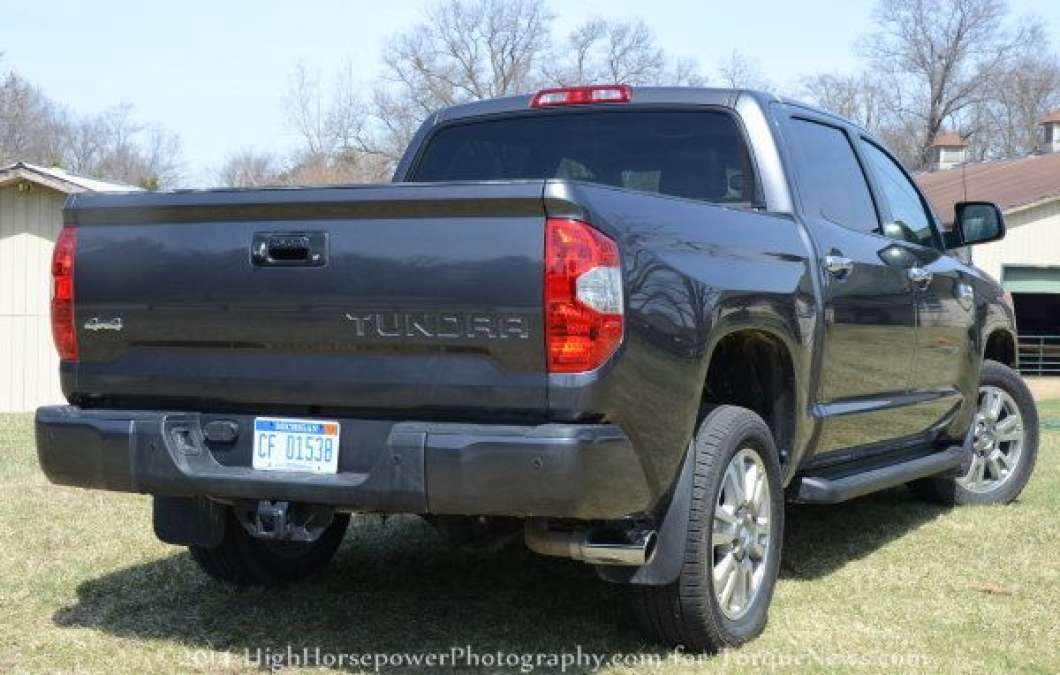
When you take the 2014 Toyota Tundra onto one of the many unpaved dirt roads around Milford Michigan, the same qualities that make for a smooth ride on paved roads transfer well to the dirt. When driving on moderately rough roads, the suspension does an awesome job of cushioning much of the harshness out of the ride so a grated dirt road won’t beat you and your passengers up like it does in a truck with a stiffer suspension setup. The problem with that is that as you get into much rougher dirt roads with large potholes, ditches and washed out areas, the suspension of the Tundra doesn’t provide the same stability as you get with the competition. Again, I recognize that few truck owners are going to spend a ton of time blasting down rough unpaved roads, but that is just another place where the Tundra trades superior ride quality in normal driving situations for less capabilities in more extreme conditions.
Hauling a Heavy Load
During one of my drives, I had to take the new Tundra to the local feed store for 1,200 lbs of bagged grain. Even with the smallish bed of the 2014 Tundra Crew Max, I didn’t have any problems fitting 24 50lb bags of grain and as I expected, that extra weight in the bed didn’t hurt the performance of the truck. The powerful iForce V8 hardly stressed to move that weight and only under harder cornering did I really notice that the weight was back there as it did cause a touch of oversteer. However, that is true of any of the modern trucks loaded with a half ton of horse feed and thrown into the twisties so I felt that in terms of hauling, the Tundra performed as well as any half ton truck I’ve tested.
Trailer Time
Finally, it was time to hook up the trailer to the 2014 Toyota Tundra Platinum Crew Max. The Tundra has a rear view camera that makes hooking up a trailer a snap, although I would love if the camera was centered on the switch rather than off to the side. Even with the location, it still made for quick and easy looking up to the trailer while the integrated 4- and 7-pin connectors in the bumper face make plugging in a cinch. Unfortunately, the Tundra does not come with the integrated trailer brake controller that you can get in the American half ton trucks, but at no point did I have any problems stopping the new Toyota pickup with my 5,000lb trailer hitched up. For those owners towing the weight of my small trailer, I wouldn’t worry much about the lack of a brake controller, but those Tundra owners who plan to pull closer to the capacity should look into an aftermarket unit.
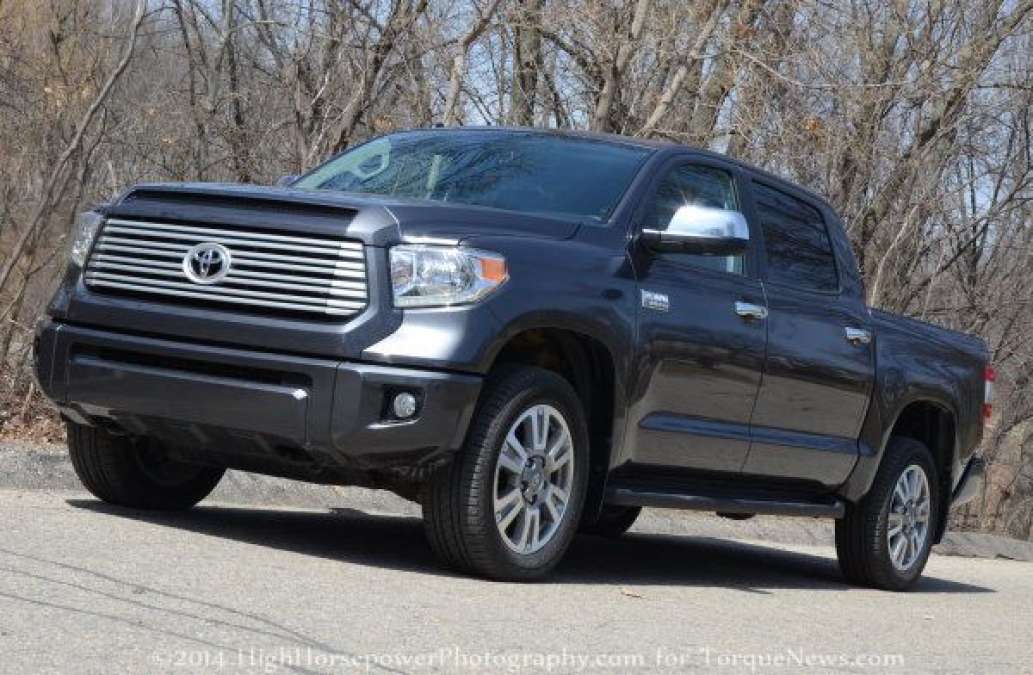
After loading a couple of our champion thoroughbreds into our small two horse trailer along with a couple hundreds of pounds of hay in the bed and 3 passengers, we hit the road for the horse show an hour away. On the trip, I would take the loaded up Tundra down a variety of road surfaces including rough paved roads, bumpy unpaved roads and a good ol Michigan highway. In much the same way that the Tundra offers a nice, smooth ride unladen, it provides a similarly smooth ride with the trailer hooked up and the cabin loaded. Whether you are pulling away from a stop light or accelerating into highway traffic, the Toyota V8 has no problems pulling the added weight. When cruising at highway speeds, the iForce engine wasn’t working particularly hard and in terms of half ton engines, the Tundra didn’t feel like it was working any harder than any other truck on the market.
The only downside that I noticed while trailering with the 2014 Toyota Tundra was a bit of “float” on certain road surfaces. When on the highway in an area where there were rhythmic bumps due to the seams in the road, the front end tends to bob a bit as you hit each bump. This was a bigger problem across the entire truck segment in the past and while Toyota has refined this problem a bit with these new models, it is a tad more severe than with the other trucks. As you might have guessed, this is nitpicking and I would bet that most people getting into their first truck won’t notice this issue when towing. However, an experienced truck owner who tows as much as I do will likely notice this float on the highway and around town on uneven road surfaces. The suspension also allows a touch more body roll than I have experienced with the other half ton trucks, but it isn’t significant enough to even be of concern to newer truck drivers. Again, this is one more inch in a battle of inches.
The Final Word
While I have some criticisms of the 2014 Toyota Tundra Platinum Crew Max, they are all very minor issues in a segment where the only real differences might go unnoticed during the pre-purchase test drive process. Make no mistake, this new Tundra is the best full size truck from a Japanese automaker to ever hit American soil so never before has the battle between the Tundra, the Ford, the Chevy and the Ram been as close as it is right now. For a long time, the Tundra was a reasonable alternative to truck buyers who want something different from the American trucks, but in the past the Tundra came with some measure of compromise. With the 2014 Tundra, the compromise will only be noticeable by those folks who have the most experience in pushing their trucks to the limits and for the average buyer – the Tundra is a truck deserving of being in the same class of truck as the Ford F150, the Ram 1500 and the Chevrolet Silverado 1500. In the past, there were big differences between the top selling American trucks and the Tundra, but this new Toyota half ton pickup is only a few inches behind the options from the Big 3 in the race to be the best truck in America.
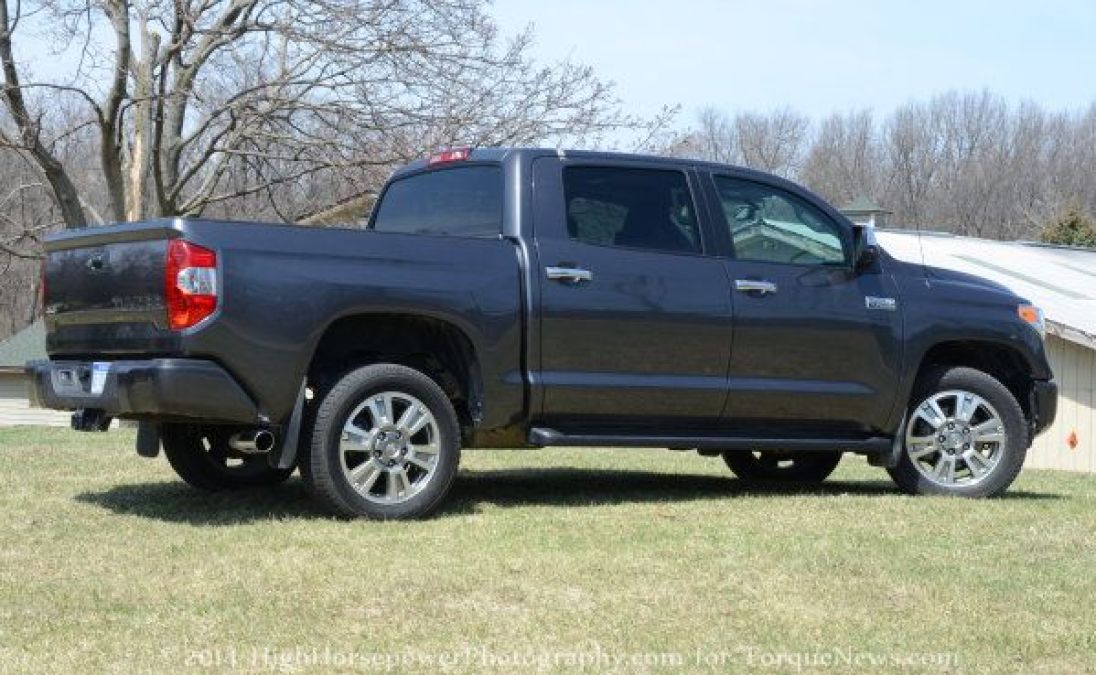
If you are in the market for a full size truck that offers a ton of power, one of the smoothest rides in the segment and a roomy, plush cabin – the 2014 Toyota Tundra Platinum Crew Max is a truck that you should make sure to drive before making your next big purchase. Best of all, in addition to offering those excellent daily driving qualities, the 2014 Tundra will tow and haul with the best of them with only a slight difference in handling – one which the average new truck buyer won’t even notice. This is an ideal truck for someone who spends most of his or her time driving on paved road with nothing but a few friends or family members; while also being impressively capable when the bed is filled or a trailer is hooked up.

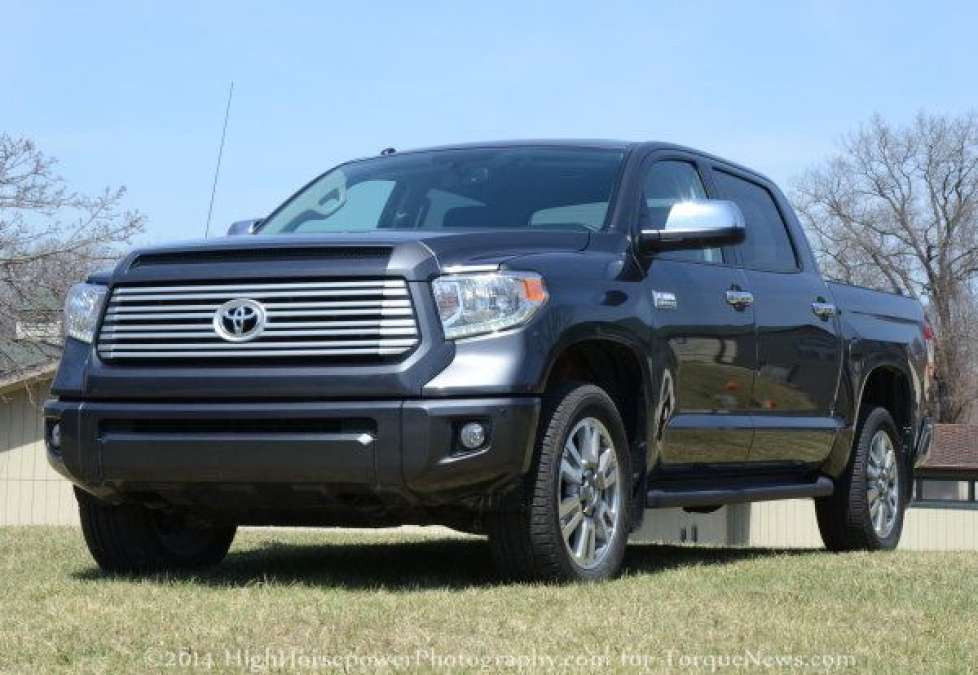




Comments
Good, fair review of the
Permalink
Good, fair review of the truck. It is interesting, though, that you say it has a smooth ride. The ride quality has been a sticking point with several truck buyers and other journalists. My understanding is Toyota is tweaking the frame and suspension to improve the ride.
It's nice to see you have
Permalink
It's nice to see you have some much nice things to say about the platinum. I own one as well and I love it. But toyota could of spent some more time and do a few thing more to this truck, like simple put lights on the door control, and dash control. At night it's a pain in the ass to see. Also the back seats, it's nice you have some much space WHEN you lift up the seat. But you can't put crap at the back of the back rest, and the door, did you try to go cheap and not put lights on the door when you open it?? The trucks rides great! Don't get me wrong. TOYOTA next time you design a truck don't ask the farmers, don't work back wards, go forward. Like you adds!
If this has a max payload of
Permalink
If this has a max payload of 1415 lbs and you put 1200 lbs of grain in, theres a good chance you were overweight. Most manufacturers calculate payload with a 150 lb driver and 1/4 tank of fuel. Plus theres the other stuff you put in your truck. Go down to local weigh station, weigh your truck with full tank of gas, and your family in it. Take the truck scale weight, and subtract from gvw, thats your real payload, or how much weight you can put in bed. Trust me it adds up quick. So this truck will haul a 9500 lb trailer with a family and thats it, nothing in bed or you will be overweight.